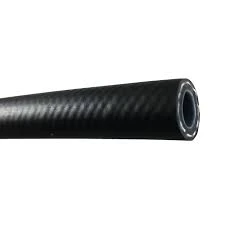335345435
Oct . 10, 2024 19:18 Back to list
twin line hydraulic hose
Understanding Twin Line Hydraulic Hose An Essential Component in Modern Machinery
In the world of hydraulics, the twin line hydraulic hose plays a pivotal role in ensuring machinery operates efficiently and safely. These hoses are specifically designed to transport hydraulic fluids through an interconnected system, making them a critical component for various applications in industries such as construction, manufacturing, and transportation. This article explores the characteristics, applications, and advantages of twin line hydraulic hoses, highlighting their significance in modern machinery.
What is a Twin Line Hydraulic Hose?
A twin line hydraulic hose consists of two parallel hoses that are bonded together, allowing them to function as a single unit. This design typically includes one hose for the flow of hydraulic fluid to the actuator and another for returning the fluid to the reservoir. The twin configuration not only simplifies installation but also minimizes the space required in compact environments, making it ideal for tight working conditions.
These hoses are constructed from high-quality materials, such as synthetic rubber or thermoplastic, and are reinforced with layers of steel wire or textile to withstand high pressures. The combination of these materials ensures durability, flexibility, and resistance to abrasions, tears, and external environmental factors.
Key Features and Benefits
1. Efficient Fluid Movement The twin line design allows for efficient movement of hydraulic fluid, reducing the risk of contamination and ensuring that the system operates at optimal efficiency. This is particularly important in high-performance scenarios where precision and responsiveness are crucial.
2. Durability and Reliability Constructed from robust materials, twin line hydraulic hoses are built to withstand the rigors of demanding environments. They resist wear and tear from exposure to chemicals, temperature fluctuations, and physical stress, ensuring long service life and reliability.
3. Ease of Installation With their integrated design, twin line hoses are easier to install in comparison to separate lines. This can lead to reduced labor costs and installation time, making it a favorable choice for maintenance and repairs in industrial settings.
twin line hydraulic hose

4. Safety Features Many twin line hydraulic hoses come with additional safety features, such as burst pressure ratings and protection against kinking or crushing. This ensures a higher level of safety during operation, minimizing the risk of hydraulic failures that could lead to accidents or equipment damage.
5. Versatility Twin line hydraulic hoses are versatile and can be used in a variety of applications, from excavators and forklifts to agricultural machinery and automotive systems. This adaptability makes them an essential choice for multiple industries, streamlining operations and improving productivity.
Applications in Various Industries
In the construction industry, twin line hydraulic hoses are commonly used in heavy machinery, including bulldozers, backhoes, and cranes. These hoses facilitate the operation of hydraulic lifts, booms, and other functions that require precise control and power.
In manufacturing, they play a crucial role in hydraulic presses, injection molding machines, and assembly equipment. Their ability to deliver consistent pressure helps maintain the quality and speed of production processes.
The transportation sector also benefits from twin line hydraulic hoses, which are used in hydraulic brake systems, power steering units, and other applications where reliable fluid transfer is necessary for safe vehicle operation.
Conclusion
The twin line hydraulic hose represents a pinnacle of engineering design in hydraulic systems, combining efficiency, durability, and flexibility. As industries continue to evolve, the demand for reliable hydraulic solutions will only increase, further emphasizing the importance of these hoses in modern machinery. Whether in construction, manufacturing, or transportation, the twin line hydraulic hose remains an indispensable component, contributing to the safe and efficient operation of hydraulic systems across the globe.
Understanding the significance of twin line hydraulic hoses can lead to better-informed choices in the selection and maintenance of hydraulic systems, ultimately ensuring optimal performance and longevity in various applications.
-
SAE 100 R17 Black Smooth Cover Hydraulic Hose
NewsMar.07,2025
-
SAE 100 R17 Black Smooth Cover Hydraulic Hose
NewsMar.07,2025
-
SAE 100 R17 Black Smooth Cover Hydraulic Hose
NewsMar.07,2025
-
SAE 100 R17 Black Smooth Cover Hydraulic Hose
NewsMar.07,2025
-
SAE 100 R17 Black Smooth Cover Hydraulic Hose
NewsMar.07,2025
-
steel wire braided hydraulic hose
NewsMar.07,2025



